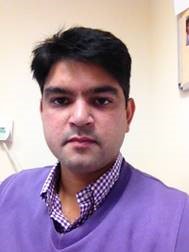The Portfolio Pathway Journey- Dr Sandeep Kamath's reflections on the process
A recent interview with a doctor, based in Wales, who progressed his career through the Portfolio Pathway describes the process. Dr Sandeep Kamath provides useful information for those thinking about making a similar step.
The SAS team in HEIW are excited to be in the process of developing bespoke training and support opportunities for SAS doctors who have further plans to develop a wide range of skills to support career aspirations, be that following the Portfolio pathway and getting their name on the specialist register or developing further skills in their present roles.
The team provides leadership for and facilitates the education, training and career progression for all SAS doctors in Wales. The team is supported by a network of SAS Tutors based in each of the Health Boards across Wales who help facilitate training and career progression for our SAS doctors. Read more about Sandeep’s journey below..

Dr Sandeep Kamath
Dr Sandeep Kamath’s career in the NHS began in 2003. He trained as a dermatologist in India and came to UK with his wife to train further in Dermatology and support her in her aspirations to be a Paediatrician. Due to various reasons including work-life balance, Sandeep decided to take up a Staff Grade post in dermatology. It was a very friendly and well-staffed department with very supportive consultant colleagues. He was also working towards completing his MRCP exams in parallel. Over the next few years, he learnt a lot in the speciality that was different to his training back home. He got used to the systems, new conditions, treatments as well as learnt a completely new field in laser dermatology. Sandeep’s skills and commitment were valued in the department and he was given opportunities to attend courses he felt relevant to his needs. When the opportunity arose, he applied to regrade to Associate Specialist and subsequently was successful in becoming the SAS Tutor for his health board.
All along, he had always kept at the back of his mind the possibility that one day he may think of applying for Portfolio pathway in dermatology. Sandeep attended all the available Portfolio pathway workshops organised by the SAS sub-group of the British Association of Dermatology as well as the GMC. He maintained a record of all the clinical activities and was engaged in, using log books, clinic letters etc. His inertia in taking the first step in starting the process ended when one of his consultant colleagues decided to leave the NHS. This created a space in the department and as the deputy, was looked upon to get accredited and apply for the consultant post that was about to be advertised. If it wasn’t for supportive consultant colleagues, secretarial staff and nurses, he would not have embarked on this tough, but rewarding pursuit!
It involved hours of trawling through clinical records and organising them in spread sheets/log books. Colleagues had to authenticate all documents which ran into many pages! It also involved them filling in assessments to mirror what the registrars would have been expected to do.
After submitting the documents, there was the agonising wait for 3 months while it went to the assessors after quality checking by the GMC. Initially it was a negative outcome but it came with recommendations that could be worked on and an ability to re-submit in 6 months. It was worth all the effort as Sandeep is now a substantive consultant in the same department that was so immensely helpful on his journey.
The bottom line for anyone thinking of going down this road is to be prepared for the long haul. Prospective data collection is easier rather than trying to go back in time. Organisation, patience, hard work and good knowledge of the requirements of the curriculum, as well as a supportive department, is the key to a successful outcome. It was all well worth it in the end!